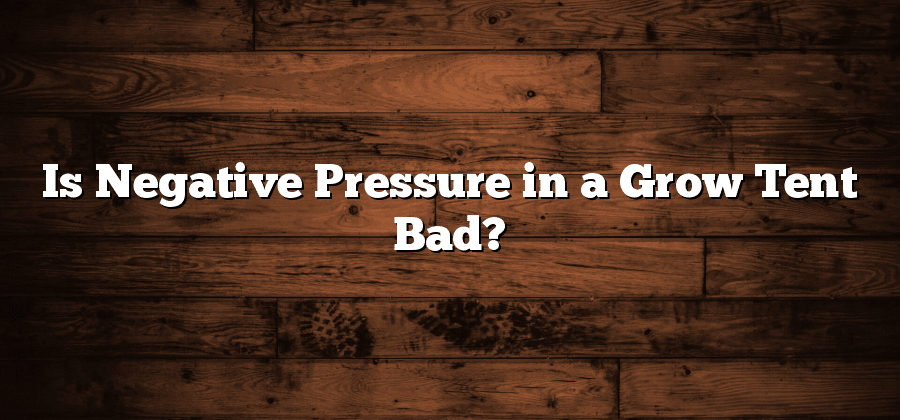Understanding Negative Pressure in Grow Tents
Negative pressure refers to the condition where the air pressure inside a grow tent is lower than the air pressure outside. This can be achieved by using exhaust fans to pull air out of the tent, creating a vacuum-like effect. Understanding and managing negative pressure is crucial for successful indoor gardening, as it directly affects the health and growth of plants.
One of the key reasons for maintaining negative pressure in grow tents is to control odors. Growing plants, especially those in the flowering phase, can release strong and distinct aromas that may not be desirable in certain environments. By creating negative pressure and using carbon filters, the air pulled out of the tent passes through the filter, effectively eliminating any odors before being released into the surrounding area. This ensures that the growing space remains discreet and doesn’t attract unwanted attention. Additionally, negative pressure can also help prevent the entry of pests and contaminants from the outside environment, further safeguarding the health of the plants.
The Role of Ventilation in Grow Tents
A crucial aspect of creating the ideal environment for plants inside grow tents is ventilation. Proper ventilation plays a vital role in ensuring the success of plant growth, as it helps to regulate temperature, humidity, and air quality inside the enclosed space. Without adequate ventilation, grow tents can become hot and humid, creating a breeding ground for pests and diseases that can harm plant health.
One of the primary functions of ventilation in grow tents is to maintain a consistent airflow. Fresh air needs to be circulated continuously within the tent, providing plants with a constant supply of carbon dioxide, which is essential for photosynthesis. Additionally, airflow helps to prevent the buildup of stagnant air and the formation of hotspots, ensuring that plants receive the necessary nutrients and moisture evenly. By promoting healthy air circulation, ventilation also helps to prevent the growth of mold and mildew, which can be detrimental to plant growth and yield.
Effects of Negative Pressure on Plant Growth
Negative pressure, when properly controlled, can have significant effects on plant growth in grow tents. One of the primary benefits of negative pressure is the ability to regulate temperature and humidity levels more efficiently. By creating a vacuum-like environment, the pull of air towards the exhaust system helps to remove excess heat and moisture, preventing the build-up of stagnant air. This, in turn, promotes better air circulation and helps plants to thrive.
Additionally, negative pressure can also enhance the plants’ ability to absorb carbon dioxide (CO2), which is essential for photosynthesis. The intake fans, working in conjunction with the exhaust system, create a constant flow of fresh air containing higher levels of CO2. This influx of CO2 helps to nourish the plants and enables them to convert sunlight into energy more efficiently. Increased CO2 levels also contribute to healthier plants with stronger stems, larger leaves, and improved overall growth.
Maintaining Optimal Airflow in Grow Tents
To achieve the best results in your grow tent, maintaining optimal airflow is crucial. Proper airflow helps to prevent the build-up of heat, humidity, and stagnant air, which can negatively impact plant growth.
One way to ensure adequate airflow is by using fans. Strategically placing fans inside the grow tent helps to circulate air, preventing hot spots and ensuring consistent temperature and humidity levels. It is recommended to have a combination of both oscillating fans and inline fans for optimal results.
In addition to fans, proper ventilation is essential for maintaining ideal airflow in grow tents. Ventilation systems, such as intake and exhaust fans, play a crucial role in removing stale air and bringing in fresh air, promoting healthy plant growth. It is important to set up a ventilation system that allows for the exchange of air multiple times per hour, as this will help to control temperature and humidity levels and prevent the risk of mold and mildew.
In conclusion, maintaining optimal airflow in grow tents is of utmost importance for the success of your plants. By incorporating fans and a well-designed ventilation system, you can create the perfect environment for your plants to thrive.






